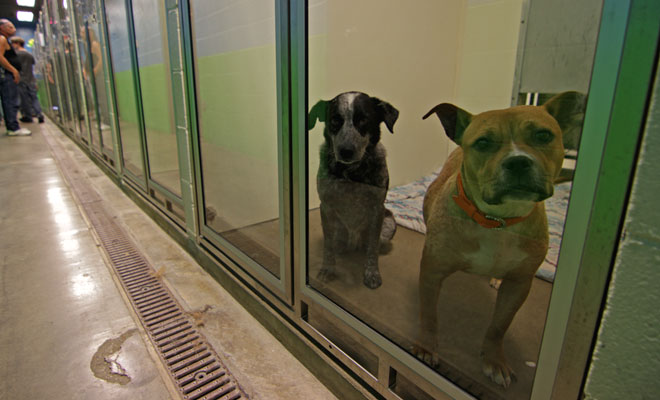
Sally Jo (left), a two-year old Heeler, and Peaches, a two-year-old Pitbull Mix, wait in a kennel inside the adoption room at the Fayetteville Animal Shelter Wednesday afternoon.
Photo: Todd Gill, Flyer staff
A group of local residents and City Council members are looking at ways to help speed up the process of lowering the euthanasia rate – or E Rate – at the Fayetteville Animal Shelter.
Shelter officials expect the E Rate to be around 25 percent by the end of 2012. Reported numbers show the rate was at nearly 50 percent in 2008.
Although the shelter has seen a dramatic decrease in the number of animals euthanized in the past five years, some believe a little more funding and support could go a long way.
But first, it’s important to look at the current situation.
A county-wide facility
Getting to this point hasn’t been an easy process, said animal services superintendent Justine Middleton, especially considering the shelter functions as a county-wide facility which takes in animals from several neighboring cities.
Middleton said 1,672 animals – or 32.5 percent of the 5,138 dogs and cats the shelter received in 2011 – came from outside Fayetteville.
While the shelter does receive about $75 for each animal brought in from outside the city, Middleton said many of those animals require extended stays which eat up both space and extra money in order to keep the animals alive.
There is hope on that horizon, though.
In 2010, Fayetteville officials told the county it would no longer accept animals from outside the city limits. As a result, plans for a Washington County animal shelter began taking shape and a new county facility is set to open later this summer.
New and continued efforts
Middleton said several efforts to decrease the shelter’s overall animal population have helped contribute to a lower E Rate in recent years.
Initiatives include a 2010 foster care program expansion, ongoing low-cost and free adoption events, an increased Facebook presence promoting available animals, and the opening of the Ranger’s Pantry pet food bank, which Middleton said has provided over 40,000 pounds of pet food to financially-strapped residents who can’t afford to feed their pets and may have otherwise turned them over to the shelter.
With continued adoption efforts and less animals being brought in, Middleton expects the E Rate to drop to about 20 percent next year and to 14 percent in 2014.
A push for “no-kill”
Members of a group called No-Kill Fayetteville say they’d like to see the city become a “no-kill” community where all adoptable and treatable animals are saved and where only unadoptable or non-rehabilitatable animals are euthanized.
Scott Harper, a spokesperson for the group, said he would like to see more access to low-cost spay and neutering, a trap-neuter-release program for feral cats, and increased cooperation with regional transport and rescue operations, among other steps outlined in a program called The No Kill Equation.
“We’ve got to spend more of our city resources toward prevention, and reducing the intake at the shelter,” he said. “We want the city to look at these proven programs that are out there.”
With extra funding and a strong push for more community support, No Kill Fayetteville members say they believe the shelter can reach standard “no-kill” E Rates of 10 percent or less.
At a recent town hall meeting, Harper suggested the city add a checkbox to monthly utility bills that would allow residents the option of donating money to the shelter.
According a recent Scripps Howard News Service examination, roughly 1,200 of the nation’s 6,700 shelters and rescue groups identify themselves as “no-kill.” And while the exact E Rates and outcomes at those facilities seem to vary, it’s clear that reducing euthanasia rates as much as possible is something both citizens and Fayetteville Animal Shelter staff are working toward.
City Council support
Ward 2 Alderman Matthew Petty said he, too, would like to see more funding and support for the shelter.
“If you could fund (a specific future program), which would it be?” Petty asked Middleton during a recent City Council agenda session.
Middleton said the biggest need is an expansion of the shelter’s spay and neuter services, specifically a high-volume, no-cost spay/neuter program. Extra staff, including a second veterinarian, would likely be required, though. “My vet just can’t do anymore than he’s doing right now,” said Middleton.
Construction of an isolation facility would also be a big help, she said. Sick animals that need to be quarantined during treatment are sometimes euthanized simply because they pose a threat to healthy animals in the shelter.
Petty said he’d support increasing the shelter’s operational budget to help expand services, but felt like money for additional facilities should come from private sources.
“We might need to turn to the community to raise some of that money,” he said.
Another council member, Ward 4’s Sarah Lewis, said she was happy a discussion was forming at the City Council level.
“The reality is there are logistical reasons why (euthanasia) occurs,” said Lewis. “And this is where the conversation about it starts.”
Dustin Bartholomew contributed to this story



